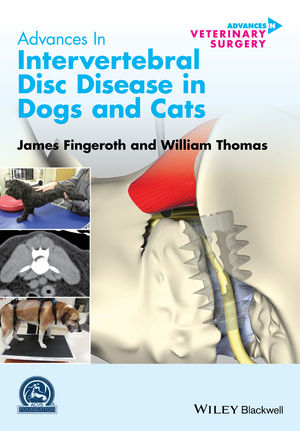
Advances in Intervertebral Disc Disease in Dogs and Cats
Wiley-Blackwell (Verlag)
978-0-470-95959-6 (ISBN)
As a comprehensive, focused work, the book is an authoritative reference for understanding and treating disc disease, providing a sound scientific and clinical basis for decision making.
Offering an objective synthesis of the current literature, the book supplies guidance on the approach to a potential disc rupture, surgical and medical strategies, and management of the patient.
Offering a complete understanding of intervertebral disc disease, the book describes and discusses the controversies and issues surrounding this topic, acknowledging the gaps in our knowledge.
Advances in Intervertebral Disc Disease in Dogsand Cats presents up-to-date, reliable information on this common condition for veterinary surgeons, neurologists, and general practitioners.
James M. Fingeroth, DVM, DACVS, is Senior Staff Surgeon at the Orchard Park Veterinary Medical Center in Orchard Park, New York, USA.
William B. Thomas, DVM, DACVIM (Neurology) is Professor of Neurology and Neurosurgery at the College of Veterinary Medicine, University of Tennessee, Knoxville, Tennessee, USA.
1. Embryology, innervation, morphology, structure andfunction of the canine intervertebral disc
2. Biomechanics of the intervertebral disc and spinal motionsegments
3. Comparisons between biped (human) and quadruped(canine/feline) discs and disc disease
SECTION 2: DISC DISEASE: DEGENERATIVE AND OTHERPATHOLOGY
4. Pathogenesis of intervertebral disc degeneration in dogs
5. Historical and current nomenclature associated withintervertbral disc pathology
6. What is known about the incidence of disc disease inchondrodystrophoid dogs?
7. Why do discs displace?
8. Spondylosis deformans and related conditions
9. Feline disc disease
10. Is "Wobbler" disease related to disc disease?
11. What is fibrocartilagenous embolism and is it related toIVDD?
SECTION 3: CLINICAL FEATURES OF INTERVERTEBRAL DISCDISEASE
12. History, neurologic examination, and neuroanatomiclocalization for spinal cord/nerve root disease
13. Spinal cord compression vs.spinal cord contusion secondaryto intervertebral disc herniation: A clinical perspective
14. "Discogenic"pain (signs associated with IVDD withoutherniation): Does it occur?
15. Traumatic disc extrusion
16. Deep pain: How should test and interpret nociception?
17. Imaging studies for the diagnosis of IVDD: Radiography,Myelography, Computed Tomography, CT-Myelography, and MagneticResonance Imaging
18. The role of non-imaging-based diagnostic studies forIVDD
19. Disc neoplasia
20. Discospondylitis and related infectious disorders of thevertebral column
21. Ascending/Descending myelomalacia secondary to IVDD
22. When should dogs be referred for surgical management?
23. Recurrent disc herniation
24. Client communications when confronted with a patient withsuspected IVDD
SECTION 4: NON-SURGICAL AND ADJUNCTIVE MEDICAL MANAGEMENT OFIVDD
25. Steroid use in intervertebral disc disease
26. Non-steroidal anti-inflammatory drugs, muscle relaxants andopioids
27. Neuroprotective treatments for acute spinal cord injuryassociated with intervertebral disc herniation
28. Acupuncture/electroacupuncture
29. Activity and nursing care recommendations
SECTION 5: SURGICAL MANAGEMENT OF INTERVERTEBRAL DISCHERNIATION
30. What constitutes spinal cord decompression?
31. General principles of spinal surgery for intervertebral discherniation
32. Cervical disc disease: Ventral "slot" vs. Lateral vs.Hemilaminectomy vs. Dorsal laminectomy approaches
33. Thoracolumbar disc disease: Dorsal vs. Lateral vs. Ventralapproaches, and what to do if I'm on the wrong side?
34. Lumbosacral disc disease: Is vertebral stabilizationindicated
35. Is there a role for durotomy during surgery forintervertebral disc herniation?
36. What should cover the bone defect afterlaminectomy/hemilaminectomy?
37. Prophylactic fenestration: Arguments in favor
38. Prophylactic fenestration: The potential argumentsagainst
39. Discography and (Chemo)nucleolysis
40. Laser disc ablation as an alternative to prophylacticfenestration
SECTION 6: POST-OPERATIVE MANAGEMENT
41. Physical therapy/rehabiliation for the paralyzed patient
42. Managing urine retention and incontinence in the paralyzedpatient
43. Nursing care needs for the paralyzed patient
SECTION 7: FUTURE DIRECTIONS
44. Minimally invasive techniques for spinal cord/nerve rootdecompression
45. Is there a role for disc prostheses in small animals?
| Erscheint lt. Verlag | 2.3.2015 |
|---|---|
| Reihe/Serie | AVS - Advances in Vetinary Surgery |
| Verlagsort | Chicester |
| Sprache | englisch |
| Maße | 185 x 252 mm |
| Gewicht | 920 g |
| Einbandart | gebunden |
| Themenwelt | Sachbuch/Ratgeber ► Natur / Technik ► Tiere / Tierhaltung |
| Veterinärmedizin ► Kleintier ► Chirurgie | |
| Veterinärmedizin ► Heimtier ► Krankheitslehre | |
| Schlagworte | Chirurgie Katze • Chirurgie (Veterinärmedizin) • Hunde; Veterinärmedizin • Tierheilkunde |
| ISBN-10 | 0-470-95959-2 / 0470959592 |
| ISBN-13 | 978-0-470-95959-6 / 9780470959596 |
| Zustand | Neuware |
| Haben Sie eine Frage zum Produkt? |
aus dem Bereich


